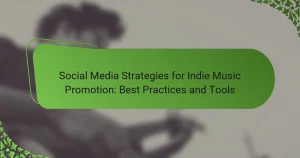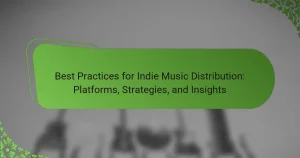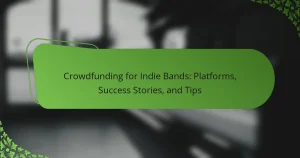Community engagement is crucial for indie music, enhancing connections and collaborations among artists and fans. Local events and social media platforms like Facebook and TikTok facilitate these interactions. Collaborative efforts foster creativity and support networks, while understanding cultural differences can tailor engagement strategies. Ultimately, a vibrant community amplifies the reach and impact of indie music.
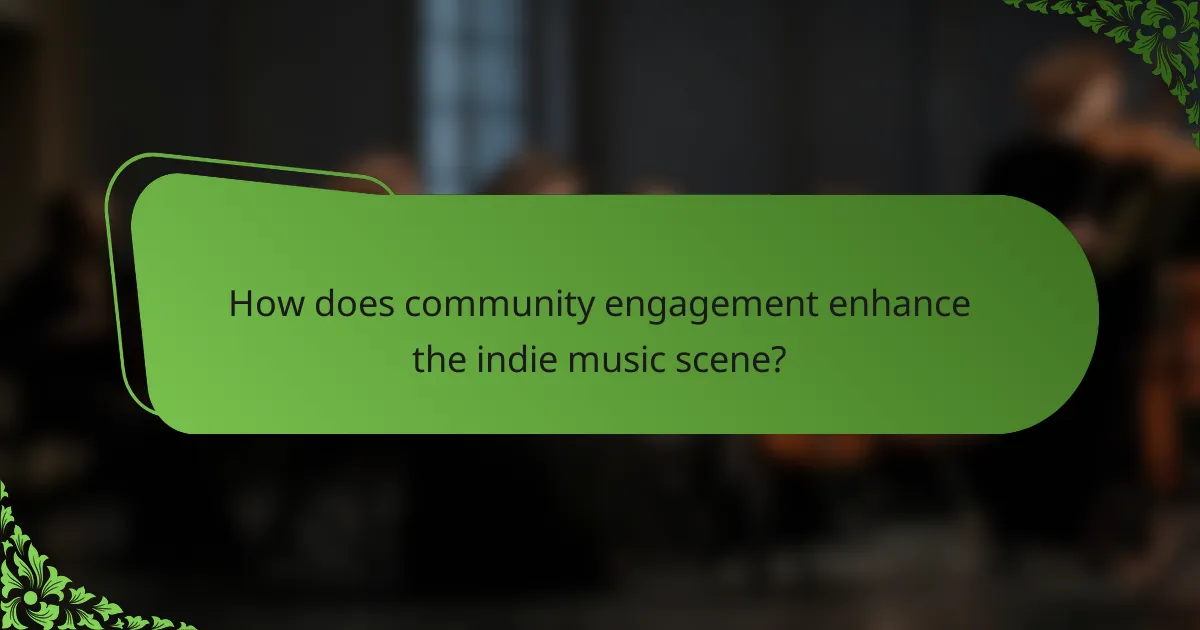
How does community engagement enhance the indie music scene?
Community engagement significantly enhances the indie music scene by fostering connections and collaborations among artists and fans. Active participation creates a supportive environment that nurtures creativity and innovation. Local events, such as open mics and festivals, allow artists to showcase their work and build relationships with audiences.
Moreover, community-driven platforms enable musicians to share resources and knowledge, promoting collective growth. Collaborations between artists often arise from these connections, leading to unique musical projects that reflect diverse influences. This synergy strengthens the indie music identity and encourages new talent to emerge.
As a result, a vibrant community not only sustains the indie music scene but also amplifies its reach and impact. Engaged fans become advocates, helping to spread awareness and appreciation for indie music. Ultimately, community engagement serves as a catalyst for artistic expression and cultural enrichment within the indie music landscape.
What are the key benefits of community involvement for indie musicians?
Community involvement offers indie musicians numerous benefits that enhance their careers. Engaging with local audiences fosters loyalty and support, creating a strong fan base. Collaborating with other artists leads to creative growth and innovation, expanding musical horizons. Networking through community events opens doors to opportunities like gigs, promotions, and partnerships. Additionally, community participation builds a sense of belonging, which can motivate artists and reduce feelings of isolation in the competitive music industry.
How do local events foster connections among artists and fans?
Local events create meaningful connections among artists and fans by providing a shared space for interaction. These gatherings foster collaborations, allowing artists to showcase their work and engage with their audience directly. Fans gain a deeper appreciation for the music and the creative process behind it.
Moreover, local events often feature diverse performances, enhancing community engagement and promoting inclusivity. This interaction cultivates a sense of belonging, encouraging fans to support local talent. As a result, artists can build a loyal fanbase, which is crucial for their growth and visibility in the indie music scene.
In essence, local events serve as a vital platform for networking, collaboration, and community building, enriching the indie music ecosystem.
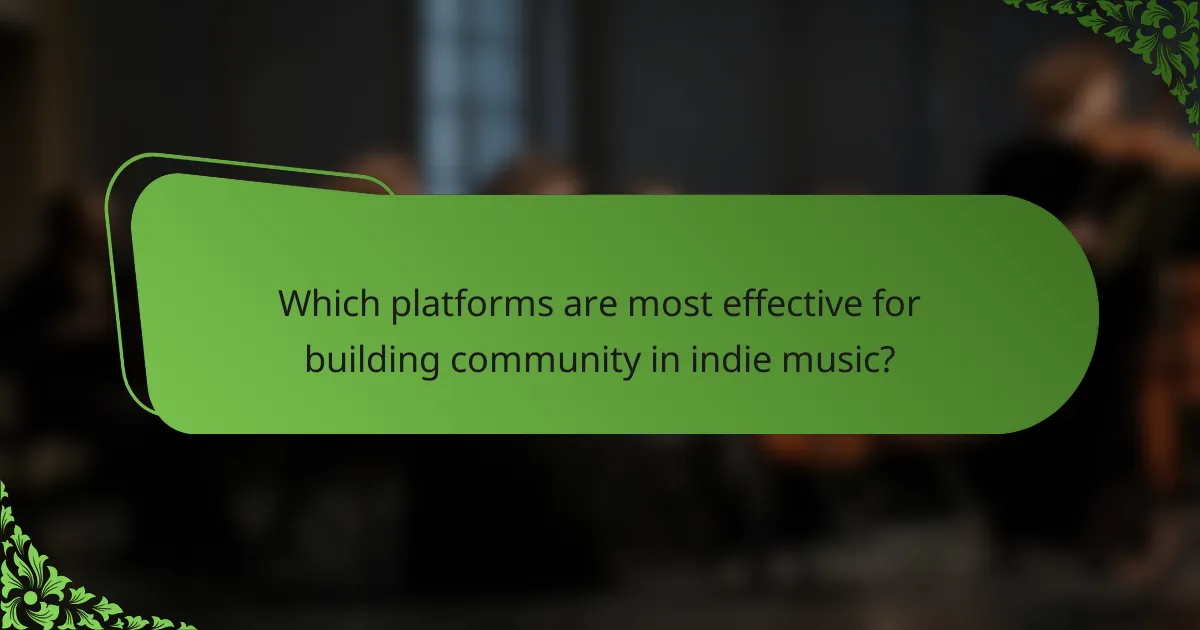
Which platforms are most effective for building community in indie music?
Social media platforms like Facebook, Instagram, and TikTok are most effective for building community in indie music. These platforms facilitate direct interaction, promote collaboration, and allow artists to share their work widely.
Facebook groups create spaces for fans and musicians to connect, share experiences, and discuss music. Instagram’s visual focus helps artists showcase their brand and engage with followers through stories and posts. TikTok’s viral nature allows indie musicians to reach new audiences quickly through creative content.
Additionally, platforms like Bandcamp and SoundCloud foster community by enabling artists to share music and receive feedback directly from listeners. These platforms also support unique interactions through comments and playlists, enhancing the collaborative spirit in indie music.
How do social media channels facilitate artist-fan interactions?
Social media channels enhance artist-fan interactions by providing direct communication platforms. Artists can share updates, engage in conversations, and receive immediate feedback from fans. This two-way communication fosters a sense of community and belonging among listeners.
Platforms like Instagram and Twitter allow artists to showcase their personalities and creative processes, deepening connections. For example, live Q&A sessions create opportunities for fans to ask questions and interact in real-time.
Additionally, social media facilitates collaborations among artists, as they can easily connect and share ideas. This networking can lead to unique projects that benefit both artists and their audiences.
Overall, social media serves as a vital tool for indie musicians to build relationships, expand their reach, and cultivate dedicated fan bases.
What role do music streaming services play in community engagement?
Music streaming services enhance community engagement by connecting indie artists with audiences. These platforms facilitate collaboration, promote local events, and foster fan interaction. For instance, Spotify’s curated playlists often spotlight emerging talents, creating a sense of shared discovery among listeners. Additionally, services like Bandcamp empower artists to sell directly to fans, strengthening community ties. As a result, indie music thrives through accessible channels that encourage participation and support.
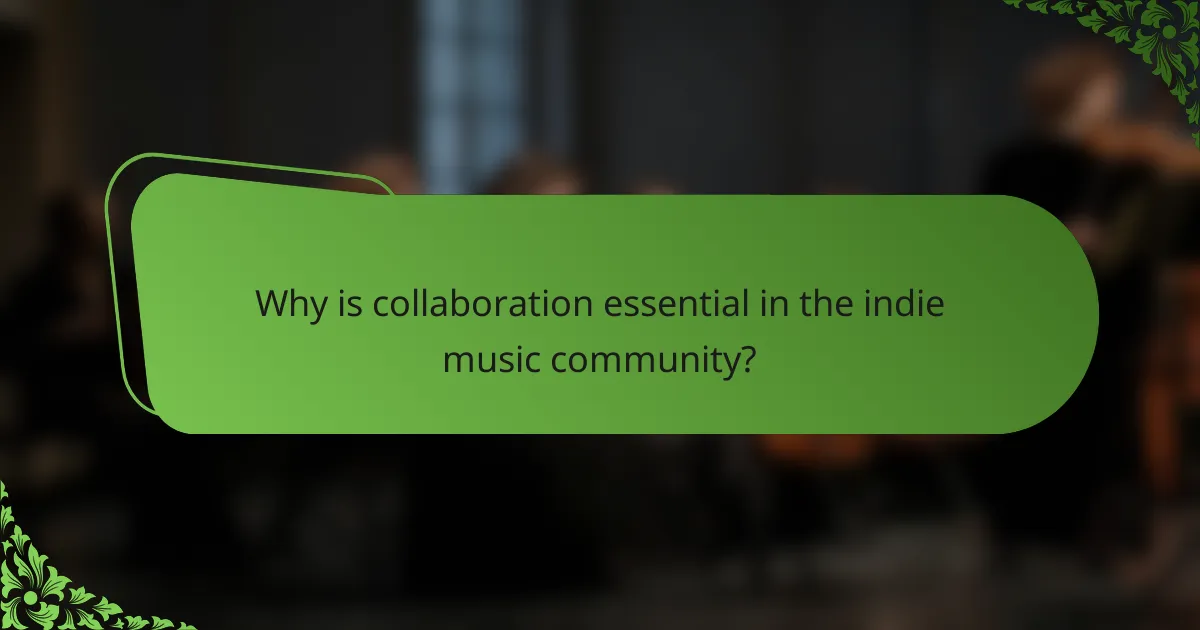
Why is collaboration essential in the indie music community?
Collaboration is essential in the indie music community because it fosters creativity, expands audiences, and builds support networks. Artists often share resources, skills, and exposure, which can lead to innovative projects and joint performances. Collaborative efforts enhance local scenes, making them more vibrant and interconnected. This synergy helps artists navigate challenges and reach greater heights collectively.
How do collaborations influence creative output and innovation?
Collaborations significantly enhance creative output and innovation in indie music. They foster diverse perspectives, leading to unique sounds and ideas. Community engagement allows artists to share resources, skills, and networks, amplifying their reach. Collaborative projects often result in innovative genres, as artists blend influences and experiment together. This synergy can drive artistic growth and inspire new trends within the music scene.
What are successful examples of cross-genre collaborations?
Successful examples of cross-genre collaborations include projects that blend indie music with other styles, enhancing community engagement. Notable instances include the collaboration between indie rock band Bon Iver and rapper Kanye West, which merged folk and hip-hop elements. Another example is the partnership between electronic artist ODESZA and vocalist Leon Bridges, combining indie electronic sounds with soulful melodies. These collaborations foster connections across diverse audiences, enriching the indie music landscape.
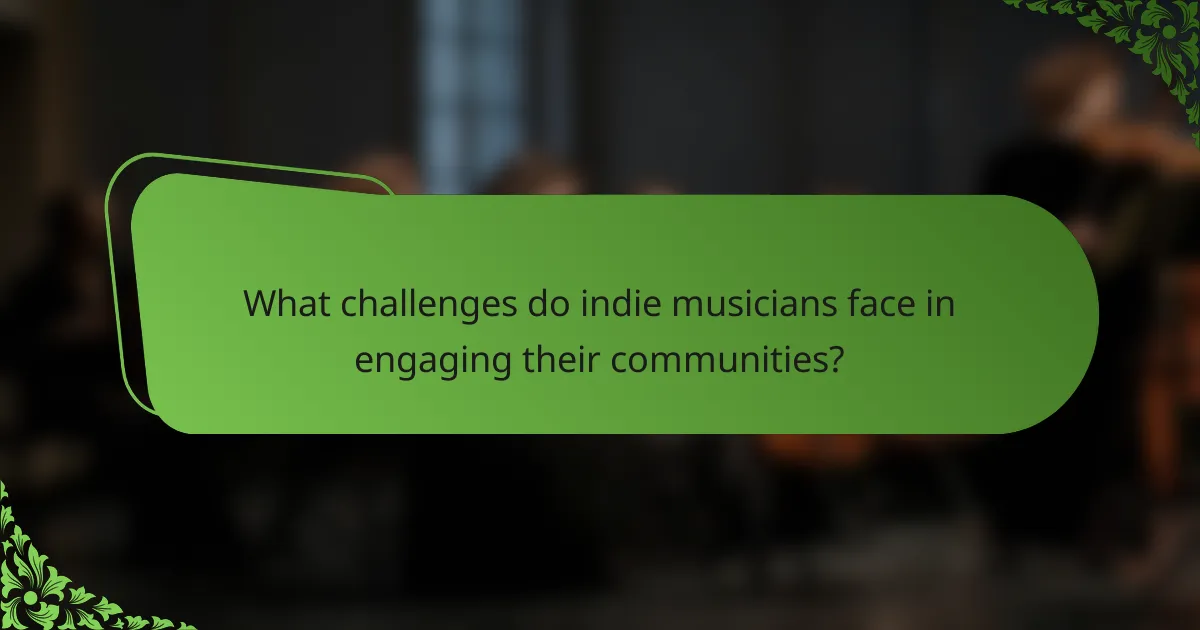
What challenges do indie musicians face in engaging their communities?
Indie musicians face significant challenges in engaging their communities, primarily due to limited resources and visibility. They often struggle with building a loyal fan base, as competition with mainstream artists is intense. Additionally, funding for community events and promotional activities is frequently inadequate.
Social media can be a double-edged sword; while it provides a platform for outreach, the sheer volume of content makes it difficult for indie musicians to stand out. Furthermore, many indie artists lack the marketing expertise to effectively connect with their audience.
Collaborations with other local artists can help overcome some of these challenges, fostering a sense of community and shared promotion. However, finding like-minded collaborators can be a rare occurrence.
Ultimately, successful community engagement requires consistent effort and innovative strategies tailored to the unique characteristics of the indie music scene.
How can indie artists overcome barriers to participation?
Indie artists can overcome barriers to participation by actively engaging with their communities. Building connections fosters collaboration, leading to increased visibility and support.
One effective strategy is to participate in local music events, which provides networking opportunities and exposure. Additionally, leveraging social media platforms allows artists to share their work and connect with fans and other musicians.
Collaborating with local businesses can also enhance community ties, as partnerships can lead to mutual promotions and increased audience reach.
Finally, seeking mentorship from established artists can provide valuable insights and guidance, helping indie musicians navigate challenges in the industry.
What are common misconceptions about community engagement in music?
Common misconceptions about community engagement in music include the belief that it is solely about performance. Many think that attending shows or festivals suffices for engagement. In reality, meaningful connections require participation in local initiatives and collaboration with artists. Another misconception is that community engagement is only for established musicians. Emerging indie artists can also significantly impact their communities through grassroots efforts. Additionally, some believe that engagement is a one-time event rather than an ongoing process. Sustained relationships and continuous efforts are essential for building a vibrant music community.
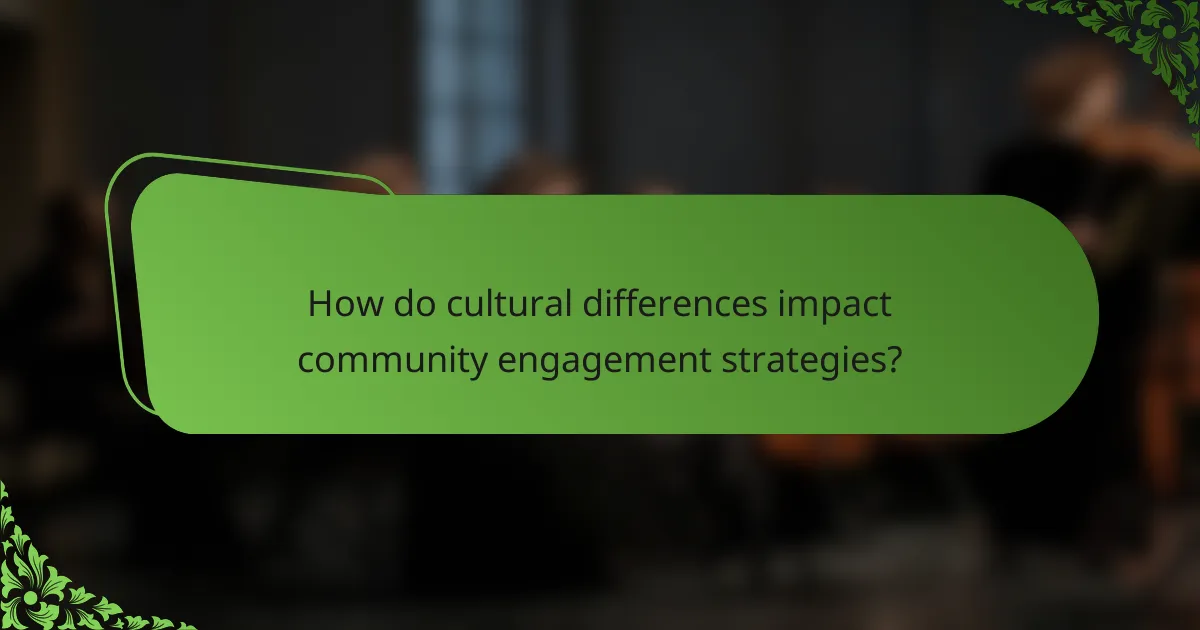
How do cultural differences impact community engagement strategies?
Cultural differences significantly influence community engagement strategies in indie music. Understanding diverse cultural contexts allows for tailored approaches that resonate with specific audiences.
For instance, local traditions and values shape how communities connect with music. In some cultures, communal music-making fosters collaboration, while in others, individual expression is prioritized.
Moreover, language barriers can impact communication strategies. Engaging with local dialects or incorporating cultural references enhances relatability and trust.
Finally, recognizing different attitudes towards music consumption can guide promotional efforts. Some communities may prefer live events, while others gravitate towards digital platforms. Adapting strategies to these preferences fosters stronger connections.
What practices are effective in diverse musical landscapes?
Effective practices in diverse musical landscapes include fostering local collaborations, promoting inclusive events, and leveraging social media for outreach. These strategies enhance community ties and support indie artists. Engaging with local venues and organizations creates platforms for artists to connect with audiences. Additionally, diverse representation in lineups enriches the musical experience for all participants.
How can artists adapt their approaches to resonate with different audiences?
Artists can adapt their approaches by engaging with diverse communities through collaboration and tailored messaging. Understanding audience preferences is crucial. For example, indie musicians can host local events that reflect community values. This fosters connections and encourages participation. Additionally, leveraging social media platforms allows artists to share their stories, creating a sense of belonging. Collaborating with local artists can enhance authenticity and broaden reach. By being responsive to audience feedback, artists can refine their artistic expressions, ensuring they resonate more deeply with listeners.
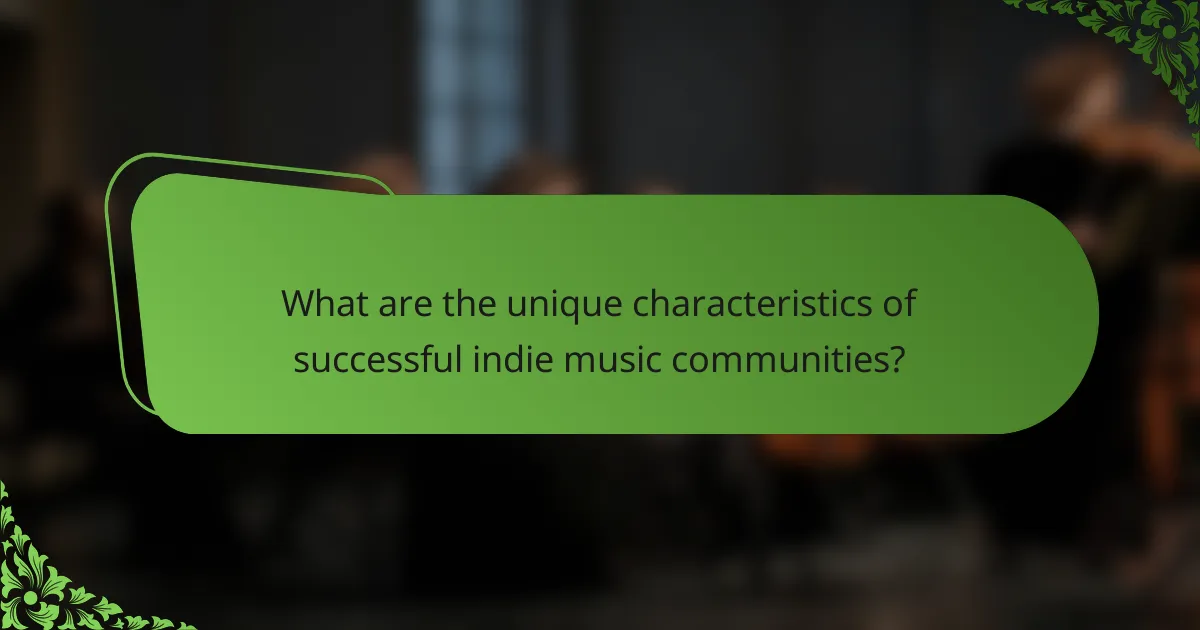
What are the unique characteristics of successful indie music communities?
Successful indie music communities are characterized by strong collaboration, inclusivity, and active engagement. Members often share resources, promote one another, and create a supportive environment. Unique attributes include grassroots organization and local focus, fostering connections that enhance creativity. Rarely, these communities may also host events that spotlight emerging artists, further solidifying their role in the indie music scene.
How do grassroots movements contribute to the indie music ecosystem?
Grassroots movements significantly enhance the indie music ecosystem by fostering community engagement and collaboration. These movements create platforms for local artists to connect with audiences, facilitating shared experiences and support networks.
Through events like local concerts and festivals, grassroots initiatives promote emerging talent while encouraging community participation. This engagement strengthens relationships between artists and fans, leading to loyal followings.
Additionally, grassroots movements often leverage social media to amplify their reach, allowing indie musicians to share their work with broader audiences. This digital engagement creates opportunities for collaboration among artists, resulting in diverse musical expressions.
Ultimately, grassroots movements are vital for sustaining the indie music scene, as they cultivate a vibrant community that nurtures creativity and collaboration.
What rare attributes distinguish thriving indie music communities?
Thriving indie music communities are distinguished by their unique attributes of grassroots support, diverse collaboration, and local cultural integration. These communities foster deep connections through intimate live performances and shared spaces. Additionally, they often prioritize inclusivity, allowing varied musical styles to flourish. This engagement creates a vibrant ecosystem that nurtures both artists and audiences, enhancing the overall music experience.
What lessons can be learned from international indie music scenes?
International indie music scenes teach valuable lessons about community engagement. They emphasize collaboration, inclusivity, and grassroots support.
Indie music fosters local connections, encouraging artists to work together and share resources. This collaboration strengthens community ties and enhances visibility. For example, artists often organize local events, creating a platform for emerging talent.
Additionally, indie scenes prioritize diverse voices, promoting inclusivity. This approach allows for a richer cultural exchange and broader audience engagement. As a result, communities become vibrant hubs of creativity and expression.
Finally, grassroots support is crucial. Local fans often drive the success of indie artists, highlighting the importance of community investment in artistic endeavors. This symbiotic relationship between artists and their audience sustains the indie music ecosystem.
What practical strategies can indie musicians use to enhance community engagement?
Indie musicians can enhance community engagement by leveraging social media, hosting local events, and collaborating with other artists. These strategies foster connections and build a supportive network.
Social media platforms allow musicians to share content, interact with fans, and promote events. Regularly engaging with followers can create a sense of community. Hosting local events, such as open mic nights or workshops, encourages face-to-face interactions and strengthens local ties. Collaborating with other musicians can introduce new audiences and create unique experiences, enhancing visibility and engagement.
By implementing these strategies, indie musicians can create lasting connections and foster a vibrant community around their music.
